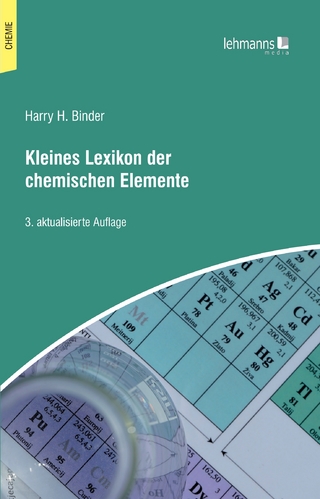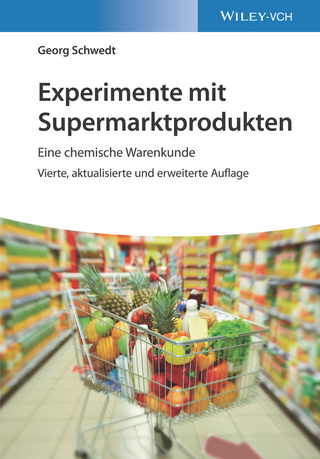
Introductory Chemistry
Brooks/Cole (Verlag)
978-0-495-83029-0 (ISBN)
- Titel erscheint in neuer Auflage
- Artikel merken
The Sixth Edition of INTRODUCTORY CHEMISTRY: A FOUNDATION, INTERNATIONAL EDITION offers unparalleled teaching and learning resources, with a robust technology package, in addition to the superior problem-solving pedagogy, engaging writing style, and strong emphasis on everyday applications that comprise the hallmarks of this best-selling text. Chemical reactions are covered early, to capture student interest, leaving more abstract material for later chapters.The authors explain chemical concepts by starting with the basics, using symbols or diagrams, and concluding by encouraging students to test their own comprehension of the solution. This step-by-step approach helps students develop critical problem-solving skills. Also, the accessible explanations and visualizations throughout the text motivate students and engage them in the material by helping them to connect abstract chemical principles to real-life experiences. The pedagogy includes chapter-opening discussions that introduce students to relevant applications and Chemistry in Focus boxes that describe everyday applications of chemistry such as artificial sweeteners, foaming chewing gum, and fake fats.
Current applications appear throughout the text with easy-to-understand explanations and analogies.
Note: Each chapter concludes with a Chapter Review. 1. CHEMISTRY: AN INTRODUCTION. Chemistry: An Introduction. Chemistry in Focus: Dr. RuthuCotton Hero. What Is Chemistry? Solving Problems Using a Scientific Approach. Chemistry in Focus: A Mystifying Problem. The Scientific Method. Learning Chemistry. Chemistry in Focus: Chemistry: An Important Component of Your Education 2. MEASUREMENTS AND CALCULATIONS. Scientific Notation. Units. Chemistry in Focus: Critical Units! Measurements of Length, Volume, and Mass. Chemistry in Focus: Measurement: Past, Present, and Future. Uncertainty in Measurement. Significant Figures. Problem Solving and Dimensional Analysis. Temperature Conversions: An Approach to Problem Solving. Chemistry in Focus: Tiny Thermometers. Density. 3. MATTER. Matter. Physical and Chemical Properties and Changes. Elements and Compounds. Mixtures and Pure Substances. Chemistry in Focus: ConcreteuAn Ancient Material Made New. Separation of Mixtures. Cumulative Review for Chapters 1-3. 4. CHEMICAL FOUNDATIONS: ELEMENTS, ATOMS, AND IONS. The Elements. Chemistry in Focus: Trace Elements: Small but Crucial. Symbols for the Elements. Dalton's Atomic Theory. Chemistry in Focus: No Laughing Matter. Formulas of Compounds. The Structure of the Atom. Chemistry in Focus: Glowing Tubes for Signs, Television Sets, and Computers. Introduction to the Modern Concept of Atomic Structure. Isotopes. Chemistry in Focus: Isotope Tales. Introduction to the Periodic Table. Chemistry in Focus: Putting the Brakes on Arsenic. Natural States of the Elements. Ions. Compounds That Contain Ions. 5. NOMENCLATURE. Naming Compounds. Chemistry in Focus: Sugar of Lead. Naming Binary Compounds That Contain a Metal and a Nonmetal (Types I and II). Naming Binary Compounds That Contain Only Nonmetals (Type III). Naming Binary Compounds: A Review. Naming Compounds That Contain Polyatomic Ions. Naming Acids. Writing Formulas from Names. Cumulative Review for Chapters 4-5. 6. CHEMICAL REACTIONS: AN INTRODUCTION. Evidence for a Chemical Reaction. Chemical Equations. Balancing Chemical Equations. Chemistry in Focus: The Beetle That Shoots Straight. 7. REACTIONS IN AQUEOUS SOLUTIONS. Predicting Whether a Reaction Will Occur. Reactions in Which a Solid Forms. Describing Reactions in Aqueous Solutions. Reactions That Form Water: Acids and Bases. Reactions of Metals with Nonmetals (Oxidation-Reduction). Ways to Classify Reactions. Chemistry in Focus: Do We Age by Oxidation? Chemistry in Focus: Oxidation-Reduction Reactions Launch the Space Shuttle. Other Ways to Classify Reactions. Cumulative Review for Chapters 6-7. 8. CHEMICAL COMPOSITION. Counting by Weighing. Chemistry in Focus: Plastic That Talks and Listens! Atomic Masses: Counting Atoms by Weighing. The Mole. Molar Mass. Percent Composition of Compounds. Formulas of Compounds. Calculation of Empirical Formulas. Calculation of Molecular Formulas. 9. CHEMICAL QUANTITIES. Information Given by Chemical Equations. MoleuMole Relationships. Mass Calculations. Chemistry in Focus: Methyl Alcohol: Fuel with a Future? Calculations Involving a Limiting Reactant. Percent Yield. Cumulative Review for Chapters 8-9. 10. ENERGY. The Nature of Energy. Temperature and Heat. Exothermic and Endothermic Processes. Thermodynamics. Measuring Energy Changes. Chemistry in Focus: Coffee: Hot and Quick(lime). Chemistry in Focus: Nature Has Hot Plants. Chemistry in Focus: Firewalking: Magic or Science? Thermochemistry (Enthalpy). Chemistry in Focus: Methane: An Important Energy Source. Hess's Law. Quality Versus Quantity of Energy. Energy and Our World. Chemistry in Focus: Veggie Gasoline? Energy as a Driving Force. 11. MODERN ATOMIC THEORY. Rutherford's Atom. Electromagnetic Radiation. Chemistry in Focus: Light as a Sex Attractant. Chemistry in Focus: Atmospheric Effects 307. Emission of Energy by Atoms. The Energy Levels of Hydrogen. The Bohr Model of the Atom. The Wave Mechanical Model of the Atom. The Hydrogen Orbitals. The Wave Mechanical Model: Further Development. Electron Arrangements in the First Eighteen Atoms on the Periodic Table. Chemistry in Focus: A Magnetic Moment. Electron Configurations and the Periodic Table. Chemistry in Focus: The Chemistry of Bohrium. Atomic Properties and the Periodic Table. Chemistry in Focus: Fireworks. 12. CHEMICAL BONDING. Types of Chemical Bonds. Electronegativity. Bond Polarity and Dipole Moments. Stable Electron Configurations and Charges on Ions. Chemistry in Focus: Composite Cars. Ionic Bonding and Structures of Ionic Compounds. Lewis Structures. Lewis Structures of Molecules with Multiple Bonds. Chemistry in Focus: Hiding Carbon Dioxide. Chemistry in Focus: BroccoliuMiracle Food? Molecular Structure. Molecular Structure: The VSEPR Model. Chemistry in Focus: TasteuIt's the Structure That Counts. Molecular Structure: Molecules with Double Bonds. Chemistry in Focus: Minimotor Molecule. Cumulative Review for Chapters 10-12. 13. GASES. Pressure. Pressure and Volume: Boyle's Law. Volume and Temperature: Charles's Law. Volume and Moles: Avogadro's Law. The Ideal Gas Law. Chemistry in Focus: Snacks Need Chemistry, Too! Dalton's Law of Partial Pressures. Laws and Models: A Review. The Kinetic Molecular Theory of Gases. The Implications of the Kinetic Molecular Theory. Gas Stoichiometry. 14. LIQUIDS AND SOLIDS. Water and Its Phase Changes. Energy Requirements for the Changes of State. Chemistry in Focus: Whales Need Changes of State. Intermolecular Forces. Evaporation and Vapor Pressure. The Solid State: Types of Solids. Bonding in Solids. Chemistry in Focus: Metal with a Memory. 15. SOLUTIONS. Solubility. Chemistry in Focus: Green Chemistry. Solution Composition: An Introduction. Solution Composition: Mass Percent. Solution Composition: Molarity. Dilution. Stoichiometry of Solution Reactions. Neutralization Reactions. Solution Composition: Normality. Cumulative Review for Chapters 13-15. 16. ACIDS AND BASES. Acids and Bases. Chemistry in Focus: Gum That Foams. Acid Strength. Chemistry in Focus: CarbonationuA Cool Trick. Chemistry in Focus: Plants Fight Back. Water as an Acid and a Base. The pH Scale. Chemistry in Focus: Airplane Rash. Chemistry in Focus: Garden-Variety Acid-Base Indicators. Calculating the pH of Strong Acid Solutions. Buffered Solutions. 17. EQUILIBRIUM. How Chemical Reactions Occur. Conditions That Affect Reaction Rates. Chemistry in Focus: Protecting the Ozone. The Equilibrium Condition. Chemical Equilibrium: A Dynamic Condition. The Equilibrium Constant: An Introduction. Heterogeneous Equilibria. Le ChOtelier's Principle. Applications Involving the Equilibrium Constant. Solubility Equilibria. Cumulative Review for Chapters 16-17. 18. OXIDATION-REDUCTION REACTIONS AND ELECTROCHEMISTRY. Oxidation-Reduction Reactions. Oxidation States. Oxidation-Reduction Reactions Between Nonmetals. Balancing Oxidation-Reduction Reactions by the Half-Reaction Method. Electrochemistry: An Introduction. Batteries. Corrosion. Chemistry in Focus: Stainless Steel: It's the Pits. Electrolysis. Chemistry in Focus: Water-Powered Fireplace. 19. RADIOACTIVITY AND NUCLEAR ENERGY. Radioactive Decay. Nuclear Transformations. Detection of Radioactivity and the Concept of Half-life. Dating by Radioactivity. Chemistry in Focus: Dating Diamonds. Medical Applications of Radioactivity. Nuclear Energy. Nuclear Fission. Nuclear Reactors. Chemistry in Focus: Future Nuclear Power. Nuclear Fusion. Effects of Radiation. Chemistry in Focus: Nuclear Waste Disposal. 20. ORGANIC CHEMISTRY. Carbon Bonding. Alkanes. Structural Formulas and Isomerism. Naming Alkanes. Petroleum. Reactions of Alkanes. Alkenes and Alkynes. Aromatic Hydrocarbons. Naming Aromatic Compounds. Chemistry in Focus: Termite Mothballing. Functional Groups. Alcohols. Properties and Uses of Alcohols. Aldehydes and Ketones. Naming Aldehydes and Ketones. Carboxylic Acids and Esters. Polymers. Chemistry in Focus: The Chemistry of Music. Chemistry in Focus: Polymers Are Tacky. 21. BIOCHEMISTRY. Proteins. Primary Structure of Proteins. Secondary Structure of Proteins. Tertiary Structure of Proteins. Functions of Proteins. Enzymes. Chemistry in Focus: Urine Farming. Carbohydrates. Chemistry in Focus: Great Expectations? The Chemistry of Placebos. Nucleic Acids. Lipids. Appendix. Using Your Calculator. Basic Algebra. Scientific (Exponential) Notation. Graphing Functions. SI Units and Conversion Factors. Solutions to Self-Check Exercises. Answers to Even-Numbered End-of-Chapter Questions and Exercises. Answers to Even-Numbered Cumulative Review Exercises. Index/Glossary. Photo Credits.
| Erscheint lt. Verlag | 15.5.2009 |
|---|---|
| Verlagsort | CA |
| Sprache | englisch |
| Maße | 221 x 274 mm |
| Gewicht | 1612 g |
| Themenwelt | Naturwissenschaften ► Chemie ► Allgemeines / Lexika |
| ISBN-10 | 0-495-83029-1 / 0495830291 |
| ISBN-13 | 978-0-495-83029-0 / 9780495830290 |
| Zustand | Neuware |
| Haben Sie eine Frage zum Produkt? |
aus dem Bereich


